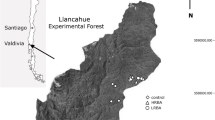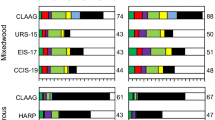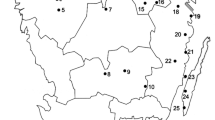Abstract
The effects of partial cutting on tree size structure and stand growth were evaluated in 52 plots in 13 stands in southeast Alaska that were partially harvested 53–96 years ago and compared with 50-year-old even-aged stands that developed after clearcutting. The net basal-area growth was greater in the partially cut plots than in the uncut plots, and basal-area growth generally increased with increasing cutting intensity. However, the basal-area growth of all of the partially harvested stands was significantly less than the growth of 50-year-old even-aged stands, and net basal area growth over the 50 year period since partial harvesting was about 33–43% of the growth of the even-aged stands. Partial cutting maintained stand structures similar to uncut old-growth stands, and the cutting had no significant effect on tree species composition. The tree size distribution of the partially harvested stands was far more complex and well distributed in comparison with the 50-year-old even-aged stands, and included the presence of several trees with diameters of more than 100 cm. These trees included both large-diameter spruce and hemlock trees and were a distinctive structural feature that was noticeably lacking in the even-aged stands.



Similar content being viewed by others
References
Alaback PB (1982) Dynamics of understory biomass in Sitka spruce-western hemlock forests of southeast Alaska. Ecology 63:1932–1948
Alaback PB (1984) A comparison of old-growth forest structure in the western hemlock-Sitka spruce forests of southeast Alaska. In: Meehan WR, Merrell TRJ, Hanley TA (eds) Fish and wildlife relationships in old-growth forests. American Institute of Fishery Research Biologists, Morehead City, pp 219–226
Barbour RJ, Zaborske RR, McClellan MH, Christian L, Golnick D (2005) Young-stand management options and their implications for wood quality and other values. Landsc Urban Plan 72:79–94
Brady JW, Hanley TA (1984) The role of disturbance in old-growth forests: some theoretical implications for southeastern Alaska. In: Meehan WR, Merrell Jr TR, Hanley TA (eds) Proceedings of the symposium: fish and wildlife relationships in old-growth forests, 12–15 April 1982, Juneau, AK. American Institute of Fishery Research Biologists, Morehead City, pp 213–218
D’Amore DV, Hennon PE, Schaberg PG, Hawley GJ (2009) Adaptation to exploit nitrate in surface soils predisposes yellow-cedar to climate change-induced decline while enhancing the survival of redcedar. For Ecol Manage. doi:10.1016/j.foreco.2009.03.006
Deal RL (1999) The Effects of partial cutting on stand structure and growth, and forest plant communities of western hemlock-Sitka spruce stands in southeast Alaska (Ph.D. thesis). Oregon State University, Corvallis, 191 p
Deal RL (2001) The effects of partial cutting on forest plant communities of western hemlock-Sitka spruce stands of southeast Alaska. Can J For Res 31:2067–2079
Deal RL (2007) Management strategies to increase stand structural diversity and enhance biodiversity in coastal rainforests of Alaska. Biol Conserv 137:520–532
Deal RL, Tappeiner JC (2002) The effects of partial cutting on stand structure and growth of western hemlock-Sitka spruce stands in southeast Alaska. For Ecol Manage 159:173–186
Deal RL, Oliver CD, Bormann BT (1991) Reconstruction of mixed hemlock-spruce stands in coastal southeast Alaska. Can J For Res 21:643–654
DeMars DJ (2000) Stand-density study of spruce-hemlock stands in southeastern Alaska (USDA Forest Service General Technical Report PNW-GTR-496). USDA Forest Service, Portland, OR
Dixon G, Johnson RR, Schroeder D (1992) Southeast Alaska/coastal British Columbia (SEAPROG) prognosis variant of the forest vegetation simulator. WO-TM Service Center, Fort Collins
Hanley TA (1993) Balancing economic development, biological conservation, and human culture: the Sitka black-tailed deer (Odocoileus hemionus sitkensis) as an ecological indicator. Biol Conserv 66:61–67
Hanley TA, Deal RL, Orlikowska EH (2006) Relations between red alder (Alnus rubra Bong.) and understory vegetation in a gradient of mixed hardwood-conifer, young growth forest. Can J For Res 36:738–748
Helms JA (1998) The dictionary of forestry. Society of American Foresters, Bethesda, 210 p
Hutchison OK, LaBau VJ (1975) The forest ecosystem of southeast Alaska. IX. Timber inventory, harvesting, marketing and trends (USDA Forest Service General Technical Report PNW-34). USDA Forest Service, Portland, OR
McClellan MH (2005) Recent research on the management of hemlock-spruce forests in southeast Alaska for multiple values. Landsc Urban Plan 72:65–78
McClellan MH, Swanston DN, Hennon PE, Deal RL, de Santo TL, Wipfli MS (2000) Alternatives to clearcutting in the old-growth forests of southeast Alaska: study plan and establishment report (USDA Forest Service General Technical Report PNW-GTR-494). USDA Forest Service, Portland, OR
Nowacki GJ, Kramer MG (1998) The effects of wind disturbance on temperate rain forest structure and dynamics of southeast Alaska. In: Shaw CG III, Julin KR (eds) Conservation and resource assessments for the Tongass land management plan revision (USDA Forest Service General Technical Report PNW-GTR-421). USDA Forest Service, Portland, OR
Schoen JW, Kirchhoff MD, Hughes JH (1988) Wildlife and old-growth forests in southeastern Alaska. Nat Area J 8:138–145
Tappeiner JC, Alaback PB (1989) Early establishment and vegetative growth of understory species in the western hemlock-Sitka spruce forests in southeast Alaska. Can J Bot 67:318–326
Tongass Land Management Plan (TLMP) Record of Decision (1997) Record of decision for Tongass National Forest land and resource management plan revision, Alaska. Alaska Region, R10-MB-338a. USDA Forest Service, Region 10, Juneau
Wallmo OC, Schoen JW (1980) Response of deer to secondary forest succession in southeast Alaska. Ecology 26:448–462
Acknowledgments
This project is a contribution from the USDA Forest Service study “Alternatives to Clearcutting in the Old-Growth Forests of Southeast Alaska,” a joint effort of the Pacific Northwest Research Station, the Alaska Region, and the Tongass National Forest. We thank Frances Biles and Judy Mikowski for assistance in graphic design and figures, and the review comments from two anonymous reviewers.
Author information
Authors and Affiliations
Corresponding author
Additional information
JFR special issue from IUFRO Uneven-Age Silviculture Conference, Shizuoka, Japan.
About this article
Cite this article
Deal, R.L., Heithecker, T. & Zenner, E.K. Comparison of tree size structure and growth for partially harvested and even-aged hemlock-spruce stands in southeast Alaska. J For Res 15, 31–37 (2010). https://doi.org/10.1007/s10310-009-0155-3
Received:
Accepted:
Published:
Issue Date:
DOI: https://doi.org/10.1007/s10310-009-0155-3




